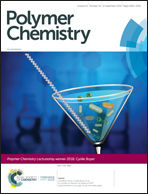3D printable non-isocyanate polyurethanes with tunable material properties†
Abstract
Green chemistry-based non-isocyanate polyurethanes (NIPU) are synthesized and 3D-printed via rapid, projection photopolymerization into compliant mechanisms of 3D structure with spatially-localized material properties. Trimethylolpropane allyl ether-cyclic carbonate is used to couple the unique properties of two types of reaction chemistry: (1) primary diamine-cyclic carbonate ring-opening conjugation for supplanting conventional isocyanate-polyol reactions in creating urethane groups, with the additional advantage of enabling modular segment interchangeability within the diurethane prepolymers; and (2) thiol–ene (click) conjugation for non-telechelic, low monodispersity, quasi-crystalline-capable, and alternating step-growth co-photopolymerization. Fourier transform infrared spectroscopy is used to monitor the functional group transformation in reactions, and to confirm these process-associated molecular products. The extent of how these processes utilize molecular tunability to affect material properties were investigated through measurement-based comparison of the various polymer compositions: frequency-related dynamic mechanical analysis, tension-related elastic-deformation mechanical analysis, and material swelling analysis. Stained murine myoblasts cultured on NIPU slabs were evaluated via fluorescent microscopy for “green-chemistry” affects on cytocompatibility and cell adhesion to assess potential biofouling resistance. 3D multi-material structures with micro-features were printed, thus demonstrating the capability to spatially pattern different NIPU materials in a controlled manner and build compliant mechanisms.

- This article is part of the themed collection: Chemical Advances in Additive Manufacturing


 Please wait while we load your content...
Please wait while we load your content...
